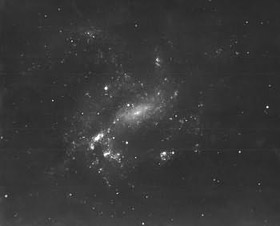"Skinny" galaxy harbors massive black hole at core
BERKELEY – Scientists have uncovered a supermassive black hole at the core of a svelte, spiral galaxy, a finding that questions a recently devised rule of thumb in which only galaxies with bulging cores have such black holes.
Dr. Alex Filippenko, professor of astronomy at the University of California, Berkeley, and Dr. Luis Ho, an astronomer at the Observatories of the Carnegie Institution of Washington, in Pasadena, discuss these results in the May 1 issue of The Astrophysical Journal Letters.
 A photo of the spiral galaxy NGC 4395, taken with the Palomar 200-inch telescope. NGC 4395 is the least luminous and nearest Seyfert galaxy, located eight million light years away. Surprisingly, despite having a supermassive black hole at its core, it has no central bulge. (Credit: Allan Sandage/Carnegie Institution) |
The scientists determined that galaxy NGC 4395, a flat "pure-disk" galaxy with no central bulge, has a central black hole approximately 10,000 to 100,000 times the mass of our sun. This suggests that other pure-disk galaxies, thought to be devoid of supermassive black holes, may indeed have one lurking within - quite possibly the featherweights of the supermassive black hole club.
"The supermassive black hole in NGC 4395 is the smallest one yet found in the center of a galaxy," said Filippenko. "This would be consistent with the galaxy having a small bulge. However, the bulge is not just small, it seems to be nonexistent."
Supermassive black holes typically range from millions to billions of times the mass of the sun, dwarfing the more common stellar black holes that are created by the runaway gravitational collapse of the cores of massive stars.
NGC 4395 is 11 million light years away in the Northern Hemisphere constellation of Canes Venatici ("the Hunting Dogs"). The galaxy has long been known to emit significant amounts of light, including visible light and X rays, from its central core region. This is a telltale sign of the presence of a central, giant black hole actively sucking in enough matter to create a swirling, superheated accretion disk. Yet, no supermassive black hole had been detected.
Filippenko and Ho used the Keck I 10-meter telescope on Mauna Kea in Hawaii and the Japanese-U.S. ASCA X ray telescope to determine that NGC 4395 indeed has a supermassive black hole, albeit an unusually light one.
"Here is an example of a massive black hole that is low in comparison to all previously reported supermassive ones, but it is definitely much more massive than stellar-class black holes, and is located in a galaxy that has no bulge," Ho said. "Thus, having a well-developed bulge is evidently not a necessary condition for the formation of massive, central black holes."
Filippenko and Ho confirmed the mass range using the velocity dispersion technique for estimating the mass of black holes, and in the process found that this powerful tool for inferring black hole mass works on scales far lower than previously thought.
Velocity dispersion refers to how fast, on average, the stars in a galactic core region are orbiting about the central black hole. It is akin to taking an average speed of a swarm of bees circling about their hive on paths (orbits) of differing size and orientation. Although predicted theoretically back in the 1990s, confirmation of a very tight correlation between velocity dispersion and supermassive black hole mass came in 2000. But until now, that correlation was always assumed to apply to black holes weighing in at millions or billions of solar masses. Using this technique on the NGC 4395, Filippenko and Ho found its mass to be 66,000 solar masses - nearly in the middle of the range found using X-ray luminosity.
This means that the black hole mass/velocity dispersion relation may apply even on scales of relatively small star clusters that contain a central, relatively light, supermassive black hole, Ho said.
The scientists also suggest that NGC 4395 may represent a unique step in the evolution of supermassive black holes, in which a bulge will develop as the black hole grows. The velocity dispersion measurements were based on a star cluster near the central black hole, a possible indication that a bulge may someday form.

